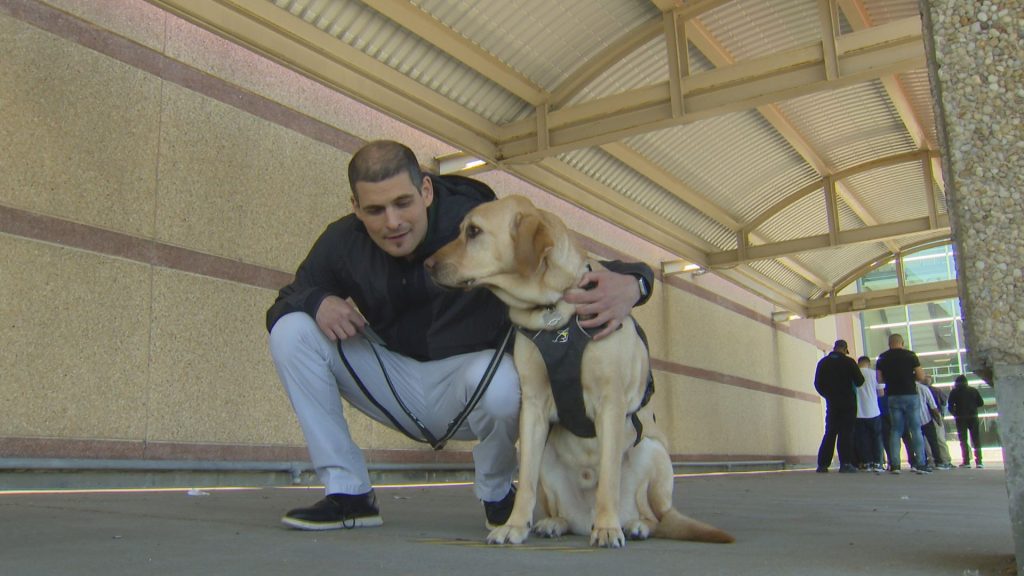‘He’s working’: Dos and don’ts of guide dog etiquette

Posted September 19, 2023 5:39 pm.
Last Updated September 19, 2023 6:12 pm.
September is Guide Dog Access Awareness Month and while it is commonly understood that guide dogs are to be allowed in almost all public spaces, it’s also important to remember that they’re not pets and should not be treated as such when out in public.
“Guide dogs are certified and they’re well-trained to do a job,” explains guide dog handler Ryan Hooey from the Canadian National Institute for the Blind (CNIB).
He was matched with his guide dog, Joe, three years ago and relies on him to go to and from places safely.
“I still have to know where I’m going and how to get there. He’s not a GPS — which is a big myth. I can’t say ‘Joe, go to the Eaton Center.’ He doesn’t know the way, he just will get me from point A to point B safely. He’s trained to stop at all street corners, and then I have to decide when it’s safe to go,” says Hooey.
One important distinction between pets and guide dogs that Hooey points out is the concept of “intelligent disobedience.”
“If I tell Joe to go or to move forward, which is the command, and he doesn’t, he will disobey me because he deems it unsafe. And that’s a testament to the certification of all guide dog schools and that they’re able to train these wonderful animals to do such great work,” he says.

Ryan Hooey and his guide dog Joe share a moment. CITYNEWS/Daniel Berry
Guide dog etiquette
Hooey says it’s natural that people want to pet guide dogs, especially since they are allowed in spaces where other animals usually aren’t — like a grocery store or restaurant.
But since guide dogs are working animals, they should not be approached as you would a house pet.
Harness on, hands off
If a guide dog has its harness or vest on, it is in work mode and should not be fed or pet.
“It’s not just petting. If you’re talking to him, he can still become distracted and lose sight of what we’re doing … and I have to go to the most extreme, if you distract my dog — we’re standing at a street corner and he steps off the corner unfortunately, we might get hit by a car,” says Hooey.
“When his [harness] is on, consider him invisible. Consider him as my mobility cane.”
When the harness comes off, Hooey says five-year-old Joe is a completely different dog and it’s alright to approach him.
“He loves to be loved. He’ll play with toys, he’ll run around. He’s a happy boy. So he gets that really good work-life balance,” he says.
Stay calm
Since guide dogs are given access to spaces that other animals are not, it is important that they stay calm in various situations.
“They’re not going to be scared of people or scared of big crowds,” says Hooey.
As such, people should not encourage play or get guide dogs excited when they’re working.
Speak to the handler
People should not greet a guide dog or other service animal directly, but rather speak to the handler.
“Joe will get distracted if you come up to him because he’s such a people dog. He loves to be loved and most dogs are like that,” says Hooey.
“If you ask more often than not, guide dog handlers will allow you to say hello.”
Guide dogs and ride sharing
As per the law, guide dogs must be allowed in taxis, including ride sharing services like Uber.
To raise awareness about guide dog etiquette and the laws around access, Uber is collaborating with CNIB to educate drivers and the public about the rights of service animals and their handlers.
“It is Uber’s policy that service animals are welcome on ride shares, but it’s also the law — drivers can be fined if they refuse service to people who use service animals and driver’s accounts can be deactivated if they refuse a ride,” explains Uber spokesperson Keerthana Rang.
Uber says last year there were 82 reported incidents where service animals were denied.
“There were probably even more that were not reported. And every single one of those incidents becomes a negative experience for an individual with a service animal, but can also become a serious safety incident,” says Rang
“We are working with CNIB to hand out CNIB blankets, lint rollers, and stickers that drivers can put on their vehicles to make ride share more welcoming for people who use service animals because we believe in equal transportation for all Canadians.”
“I’m not able to wake up in the morning and drive myself to work,” says Hooey. “It’s huge access wise when I can call an Uber and not have to worry about being denied three times.”
He says he understands that some drivers may have allergies or may not be able to come in contact with dogs due to religious reasons and says he tries to ensure that both his rights and their rights are respected.
“It’s the law and you can’t deny a person with a guide dog to get into your Uber. However, it’s about compromise — ‘if you don’t feel comfortable with a dog in your car, can you wait with me until another Uber comes? Or, hey, you’re allergic. Let’s put a blanket down. Or I can keep him as far away from you as possible,” says Hooey.
“So there’s always these compromising things that we can chat about and that we can make this work so that it’s enjoyable, it’s comfortable for everybody.”
He adds that he often messages the Uber driver assigned to him to let him know he as a guide dog.
“It’s not required — there’s that vulnerability factor and … the cat’s out of the bag, so to speak, if I say, ‘Hey, I’m visually impaired with a guide dog.’ However, in my case, I don’t like there to be any surprises,” he says.
“It’s more beneficial for me, rather than to be refused by two or three drivers, to save that time and to let them know so a driver’s okay with it, and they know what to expect when they’re coming to get me.”








